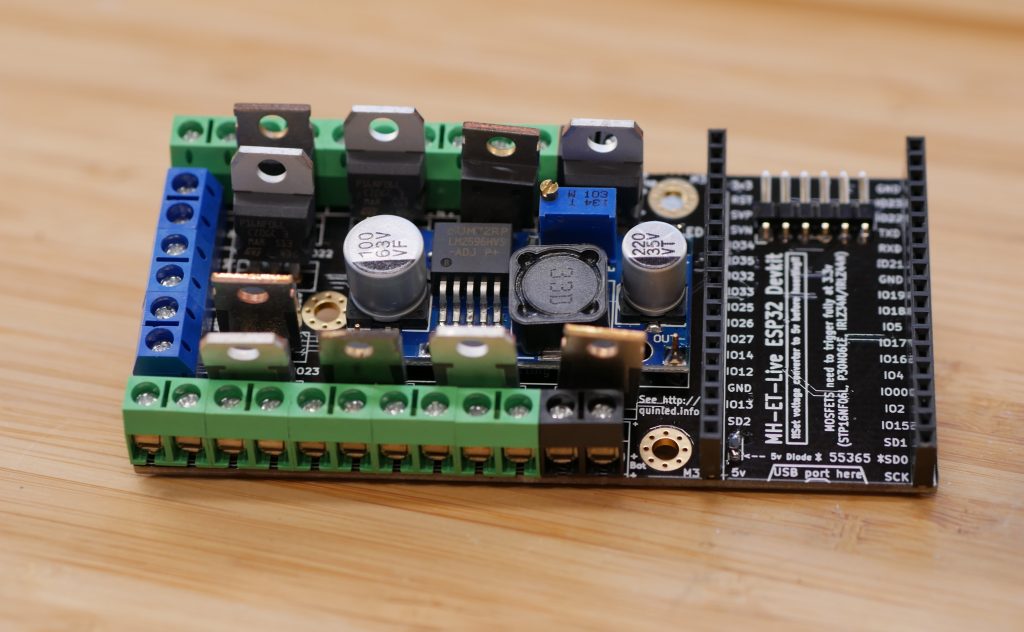QuinLED-An-Deca Specifications
Features
- MH-ET-Live ESP32 development board
- Dual-Core CPU with plenty of memory and hardware timers for PWM generation
- WiFi 2.4Ghz 802.11 N connectivity
- Wide software compatibility through Arduino IDE, Micropython or other distributions
- Onboard Micro-USB port and Reboot/EN switches
- 10 channels with TO-220 MOSFET for PWM dimming
- Tested 300.000Hz PWM dimming frequency on all channels
- Uses a 3.3v full trigger MOSFET (see hardware guide)
- 10 independant dimming channels each having their own +/- terminal pair on the board
- You don’t need to populate all channel components if you are not going to use them
- 2x Dual input terminal for maximum power input (easily converted to barrel plugs if desired)
- Voltage input and output between ~6.5v to 50v!
- Onboard DS18B20 temperature sensor
- 5 GPIO in/outputs available through pin headers (One is shared with One-Wire bus of DS18B20 Temperature sensor)
- 2x 5v + 2x 3.3v
- 2x GND pins
- 3x Mounting holes
- 3x M3
- Medium size
- Fully assembled the size is about 10cm by 5cm with a height of 2,5cm

Power handling
Power handling depends on the amount of copper that is applied to the PCB. Generally these values are 1OZ by default or 2OZ if you pay extra. Depending on your needs you need to select the right amount of copper you need in your boards.
This board has a top and bottom power in. Both are connected together and each will power all of the outputs independently or together. Still, if for instance you are only going to use the top ports on the board, also power the board using the top power input port because it’s closest and thus transfers power easiest. For high power applications it’s very much recommended to hook up both power input ports to your power supply (often they also have multiple output ports).
*One board only needs a single power connection, for higher loads use both power connectors to the same power supply!
*Hooking up multiple power supplies is possible, but not recommended! Research before doing so!
Maximum input/output voltage
The QuinLED-Deca uses an auto-scaling DC-DC converter for it’s onboard electronics. It and the MOSFETs can accept a maximum of 50v. It requires a minimum of 6.5v to operate correctly.
Maximum total power input
[1 power connector] (top or bottom)
| 1 OZ copper | 2 OZ copper | |
| 15 Amps | 25 Amps | |
| 12v | 180w | 300w |
| 24v | 360w | 600w |
| 36v | 540w | 900w |
| 48v | 720w | 1200w |
[2 power connector] (top and bottom)
| 1 OZ copper | 2 OZ copper | |
| 25 Amps | 40 Amps | |
| 12v | 300w | 480w |
| 24v | 600w | 960w |
| 36v | 900w | 1440w |
| 48v | 1200w | 1920w |
Max 1 port power output (cheap mosfet)
| 1 OZ copper | 2 OZ copper | |
| 4 Amps | 4 Amps | |
| 12v | 48w | 48w |
| 24v | 96w | 96w |
| 36v | 144w | 144w |
| 48v | 192w | 192w |
